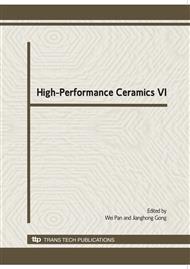p.397
p.400
p.404
p.409
p.413
p.417
p.420
p.423
p.426
Effect of Bi2O3 Addition on the Electrical and Physical Properties of Lead-Free 0.98(Na0.5K0.5)NbO3-0.02 Ba(Zr0.04Ti0.96)O3 Piezoelectric Ceramics
Abstract:
The 0.98(Na0.5K0.5)NbO3–0.02Ba(Zr0.04Ti0.96)O3 ceramics have been prepared following the conventional mixed oxide process. X-ray diffraction analysis revealed that, during sintering, all of the Ba(Zr0.04Ti0.96)O3 diffuses into the lattice of (Na0.5K0.5)NbO3 to form a solid solution, in which a orthorhombic phase with a perovskite structure was found In order to improve the sinterability of the ceramics, Bi2O3 additions were used as a sintering aid. The electromechanical coupling coefficients of the planar mode kp and the thickness mode kt reach 0.3 and 0.55, respectively, at the sintering of 1100oC for 5 h. For 0.98NKN-0.02BZT ceramics by doping 0.5 wt.% Bi2O3, the electromechanical coupling coefficients of the planar mode kp and the thickness mode kt reach 0.21 and 0.57, respectively. The ratio of thickness coupling coefficient to planar coupling coefficient is 2.7.
Info:
Periodical:
Pages:
413-416
Citation:
Online since:
March 2010
Authors:
Keywords:
Price:
Сopyright:
© 2010 Trans Tech Publications Ltd. All Rights Reserved
Share:
Citation:


